
Regardless of your level of expertise as a yoga teacher, chances are, you will have someone who is pregnant in your vinyasa yoga class at some point in your career. You don’t have to be a practicing prenatal yoga instructor to guide pregnant students but it’s important to know some basic tips to create a yoga journey that is safe and welcoming for your pregnant yogis.
This post will provide information about what pregnant women could be going through from a physical perspective during each trimester, some dos and don’ts to consider, and yoga modifications for pregnancy in a non prenatal yoga class. By the end of the post, you’ll know what to do when the moment presents itself.

What To Know About Doing Yoga During Pregnancy
First and foremost, every BODY is different, and no two pregnancies are exactly the same. Encourage your students to listen to their body, and take necessary breaks as needed throughout their practice.
If your students have a strong practice, they can continue a regular yoga routine with appropriate modifications per trimester. If your moms-to-be are new to yoga, let them know that pregnancy is not the right time to introduce difficult postures like deep backbends or tricky balancing poses into their practice. However, they can still have a satisfying experience with modified poses or those designed to support a pregnant body.
Is Yoga Safe For Pregnancy?
Yes! Yoga is safe to practice throughout pregnancy. In fact, prenatal yoga poses and pregnancy modifications can be integrated into a regular flow class for newly pregnant women and women in their second and third trimesters without changing a class sequence or feeling like you have to hover over your student.
Plus, there are immense benefits to practicing yoga while pregnant; it can reduce anxiety and stress and improve sleep patterns. That being said, it’s important to take two fundamental things into account. First, during pregnancy, a hormone called relaxin tends to loosen ligaments to prepare for birth. Remind your students to focus on strength and stability rather than overstretching (if your students can magically do the splits during pregnancy it’s relaxin-induced).
Second, pregnant women should avoid breath retention to ensure oxygen is always flowing to the baby. Encourage long deep breaths (without the holds) to help your students create a connection with their body and their breath as they practice yoga.
Remember each trimester will feel different for every person. Women tend to experience fatigue in the first trimester, gain a boost of energy in the second trimester and return to feeling fatigued in the final stage of pregnancy. Some women may not feel any symptoms during their entire pregnancy.
Listen to the needs of your pregnant students without making assumptions about what they may or may not need. And remember, blankets, bolsters, pillows, and blocks are tremendously useful tools to incorporate into any modifications you provide to your students.
Want a morning yoga routine that is safe for all trimesters? Join me on YouTube!
Pregnancy Postures: Top Yoga Adjustments And Modifications While Pregnant
While there are certain adjustments and modifications to make throughout the pregnancy, each trimester will also have its own challenges and changes. Let’s go over certain modifications with different poses for each trimester.
First Trimester Yoga
Twisted Chair Pose
Modification: Wide Leg Chair with a Heart-Opener
I know this may seem obvious, but it has to be said! A growing baby needs space to develop and closed twists constrict the space the baby needs to grow. To modify twisted chair pose, students can remain in a regular chair pose without doing the twist or they can:
- Widen their usual stance.
- Ground all four corners of the feet on the mat.
- Bend the knees to come into a wide chair pose.
- Use the arm that is close to the legs for support across the knees.
- Raise the opposite/top arm in a comfortable position to open the chest.
- Gaze towards the top arm.
- Hold this pose for 3-5 breath cycles.
- Repeat on the opposite side.
Note: Your student will be facing in the opposite direction of the class, but this is just what we want.
Tree or Eagle Pose
Modification: Tree/Eagle Pose with Wall
Poses like tree and eagle are typically safe to do in each trimester but women should still pay careful attention when trying balancing poses. This is especially important in the first trimester when the belly may not be visible but rising hormone levels may cause them to feel dizzy.
Suggest the following:
- Find a wall or a chair nearby.
- Place one hand on the chair.
- Ground all four corners of each foot onto the mat.
- Keep the foot that is closest to the chair grounded.
- Bring the opposite leg into a kickstand, below the knee, or above the knee.
- Find a non-moving gaze.
- Place the opposite hand on the hip, or bring your arm to the sky.
- Hold this pose for 3-5 breath cycles.
- Repeat on the opposite side.
Boat Pose
Modification: Opposite Arm and Leg Extension
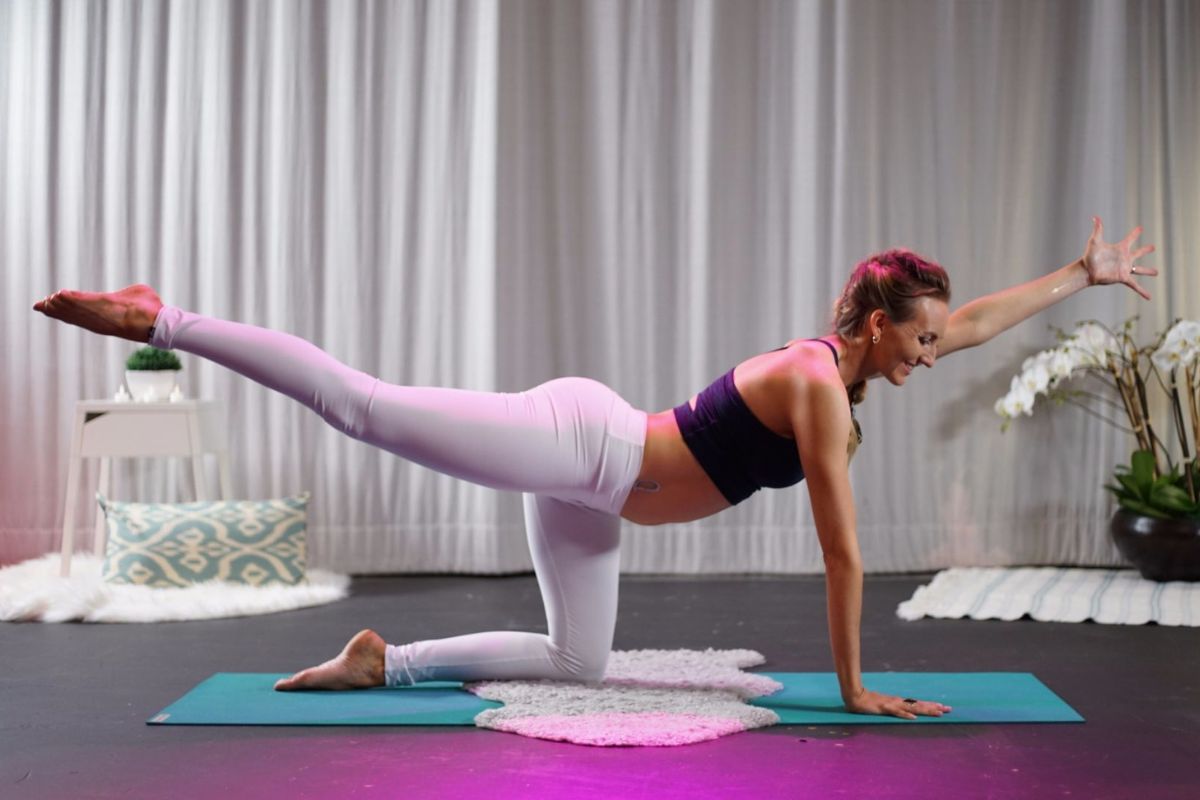
Even if the belly isn’t showing yet, it’s still a good idea to avoid compressing and putting pressure on the belly and potentially the uterus. There are core exercises other than boat pose that can be just as effective in strengthening the midsection in a safe manner.
In addition to cat–cow pose, offer this modification:
- Place knees and hands firmly on the mat.
- Lift one leg, straighten the leg toward the back of the mat.
- Lift the opposite arm and straighten it toward the front of the mat.
- Gaze toward the lifted arm to lengthen the spinal column.
- Stay here for 3-5 breaths and slowly release your hold back to the mat.
- Repeat on the opposite side after three cycles of breath.
Second Trimester Yoga
Chaturanga to Upward Facing Dog
Modification: Knees-Down Chaturanga to Downward Facing Dog
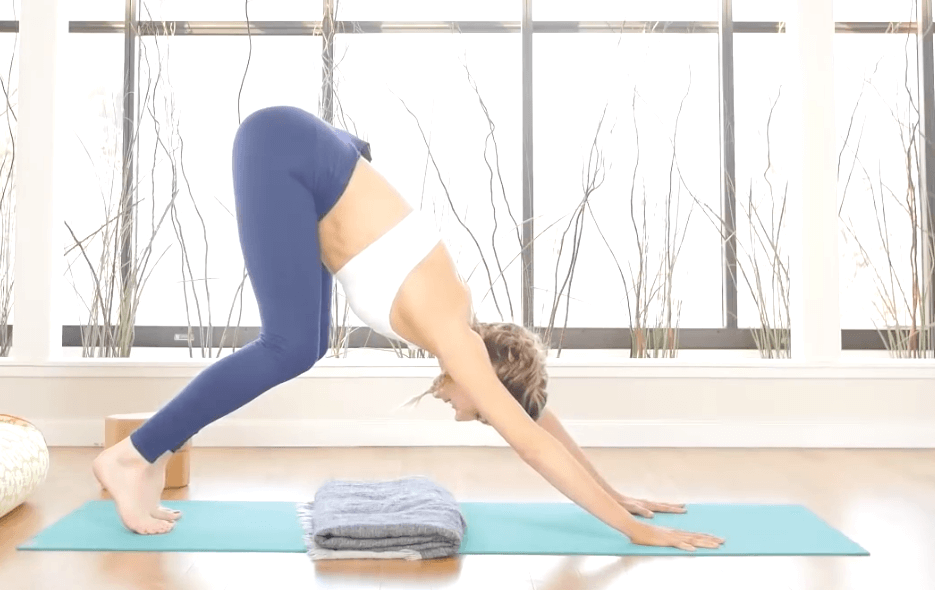
Chaturanga to upward facing dog may feel comfortable for some pregnant women but others may not feel so great with this type of movement. The weight of their belly can place extra pressure on their lower back, compromising the pelvic lift when they are in this pose.
Placing knees on the ground will reduce strain in the lower back. As an option, use blocks under both hands to create more space for the baby belly.
- From a high plank position, place both knees on the mat and tuck the tailbone to maintain a long spine
- Shift your body slightly forward, breathing into the upper back as you prepare to lower
- Bend your elbows to touch your ribcage.
- Keep your gaze forward to lengthen your spine.
- Try chaturanga pushups. (optional)
- Tuck your toes, bring your hips up and back.
- Come to downward dog.
Bow Pose
Modification: Camel Pose Variation
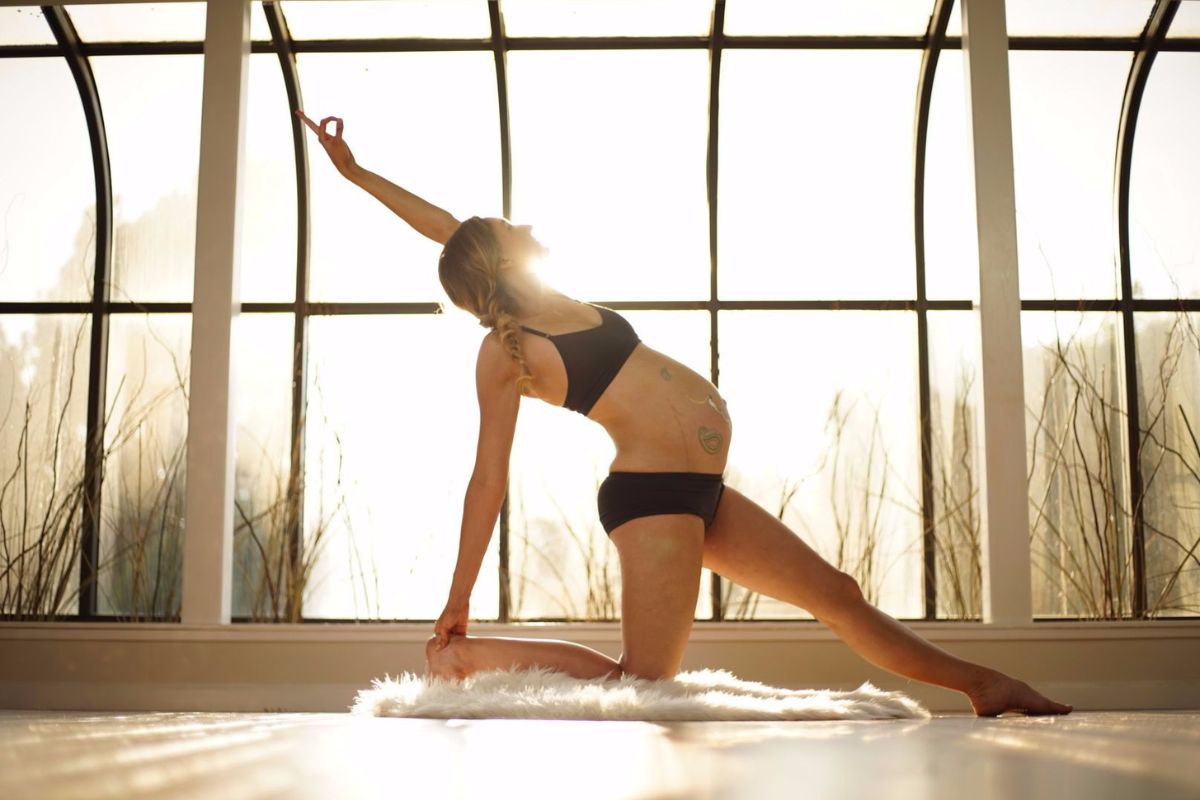
After the first trimester, lying face down on your belly is a big no-no due to the compression on the stomach, but there are still options to modify belly-down poses. Camel pose is a wonderful alternative because it works the back muscles and still provides the yogi with a heart opening stretch.
Here’s how to modify this pose:
- Begin by kneeling upright with your knees hip-distance apart.
- Rest your hands on the back of your lower back or butt, fingers pointing toward the floor.
- Feel free to lift your chin up towards the ceiling for this heart opener.
- Stay here for 3-5 breaths and release.
Alternatively, you can offer another variation like in the picture above. If students are able to and comfortable, they can extend one leg forward, like in the picture above, and reach back with the opposite hand to find your heel. Extend the other arm into the air above and hold for 3-5 breaths.
Revolved Side Angle
Modification: Supported Side Angle
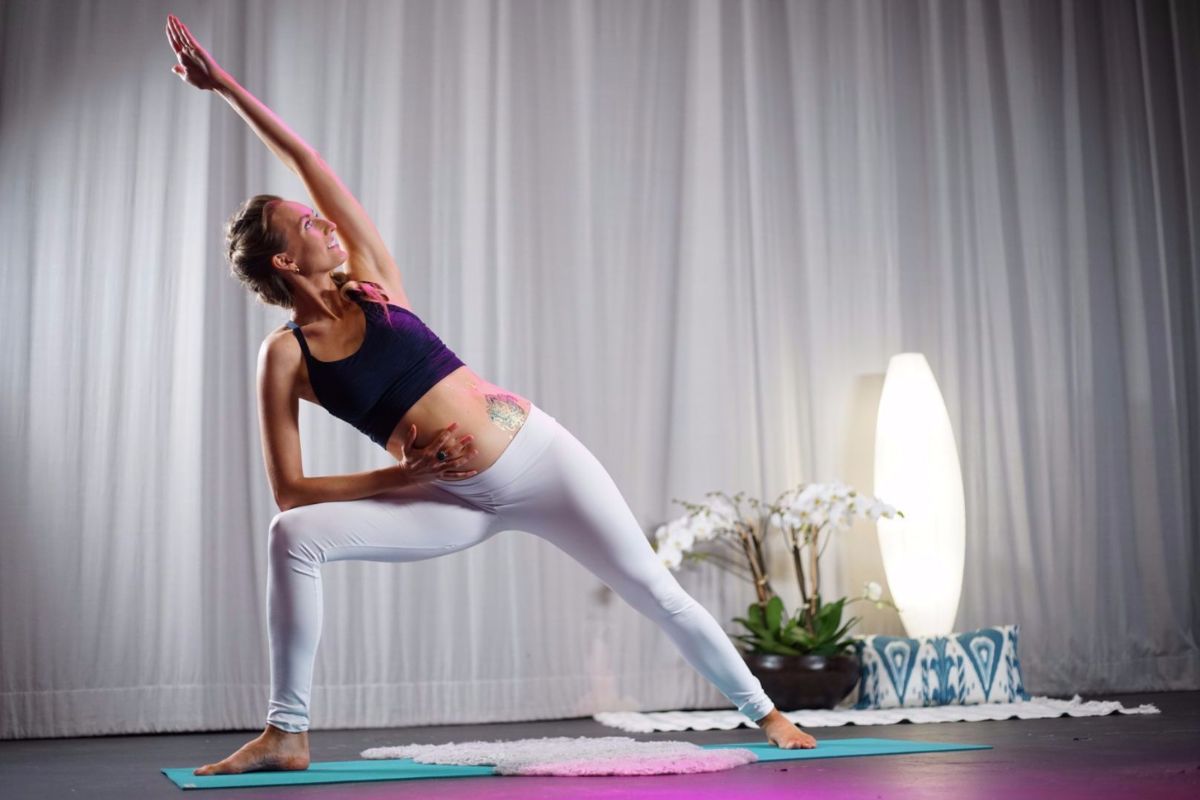
As I mentioned in a previous section, pregnant students should avoid closed twists. The baby is trying to grow and needs the space to do it!
To modify this pose, suggest a regular side angle pose so students can open up to one side of their body. Here’s how to get them into this stretch:
- Come into a warrior two stance.
- Bring your arm that’s aligned with the front-facing foot onto your thigh. Rest the top of your forearm here.
- Swing your other arm in front of your belly and up toward the ceiling.
- Gaze is upward toward your fingertips.
- Stay here for 3-4 breaths.
- Repeat on the opposite side.
Third Trimester Yoga
Full Wheel
Modification: Supported Bridge Pose
A full wheel pose doesn’t have to be completely ruled out for pregnant yogis; as I’ve said before, every BODY is different. But there may be limited mobility in the third trimester and students shouldn’t be pushing themselves at this stage in their pregnancy.
For students uncomfortable with attempting wheel, a supported bridge pose is a wonderful option because it elevates the hips, temporarily alleviating pressure in the pelvic floor.
Here’s how to bring your students into a supported bridge pose:
- From a lying position, bend your legs so the soles of your feet are on the mat.
- Bring your heels toward your seat, hip-width distance apart.
- Bring your fingertips toward your heels.
- Push your palms onto the mat and slowly lift your hips from the end of your spine towards the top of your spine.
- Place a block underneath your sacrum and lower your body onto the block.
- Stay here for 3-5 cycles of breath. Remove the block and slowly lower your hips back to the mat.
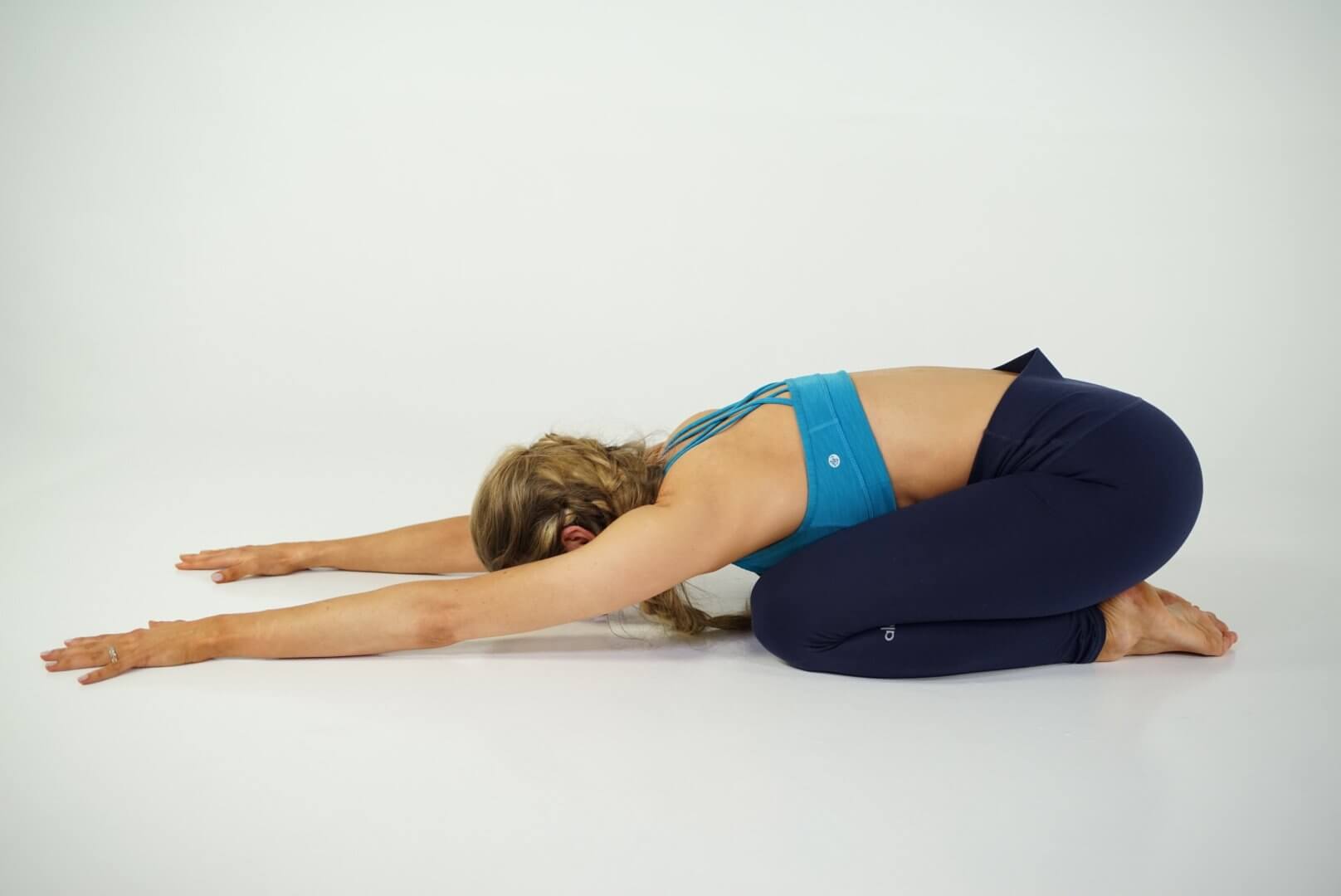
Child’s Pose
Modification: Child’s Pose with Support
Child’s pose is a great pose that is restorative and can relieve pressure in many areas of the body from the hips, to the lower back, and even the shoulders. However, a regular child’s pose may feel very uncomfortable in the third trimester due to the positioning of the belly.
Guide your students into a supportive pose using these queues:
- Find supportive tools like a rolled blanket, a bolster, or a second bolster.
- From a kneeling position, bring your toes to touch and separate your knees, bringing them slightly wider than the mat.
- Place your props on the mat in front of your body so it’s positioned in a way that supports your chest and head.
- Slowly lower your torso onto the props.
- Your head and chest should be completely comfortable and feel supported, leaving plenty of room for your belly.
- Relax your arms on either side of your body or hug the bolster if you have one.
- Enjoy 6-8 cycles of breath before bringing yourself back into a seated position or hero’s pose.
Shoulder Stand
Modification: Legs Up The Wall
Inverting a pregnant body into a shoulder stand pose at this stage is not recommended due to the added weight to the belly. Being inverted in this position can lead to compression of the upper spine, symptoms of heartburn, and dizziness.
Instead, legs up the wall is a restorative yet effective modification that aids in blood circulation, reduces swelling in the legs and feet, and may relieve lower back pain for pregnant yogis.
Guide your students into this pose through the following steps:
- Place a bolster or folded blanket against the wall.
- Sit to the left of your props and stack your knees to the left.
- Bring your seat as close to the wall as possible.
- Gently lower your body and lie on your left side.
- Roll your seat right onto your props.
- Shimmy your body toward the wall until it touches.
- Extend your legs about hip-width distance apart.
- Rest here for 6-8 cycles of breath.
- Roll onto your left side body.
- Bring yourself back to a seated position.
Yoga Poses To Avoid When Pregnant
Staying active (if possible) can help students experience a more comfortable pregnancy and reduce the risk of complications. However, it’s important to avoid certain poses while pregnant to ensure blood is flowing to the baby, more space is created for the belly, and to protect the abdominal muscles from separation (also known as diastasis recti – a common issue that many women are not aware of).
- Avoid deep twists and closed twists. These poses compress the belly; offering open twists can create space in the belly.
- Full splits and deep stretches. It’s one thing if your students were able to do this pose prior to pregnancy, but relaxin-assisted splits can cause overstretching and can damage ligaments
- Forward fold and bend. A regular seated forward fold or standing forward bend with feet together does not create space for a growing belly. These poses compress the belly and may cause cramping. Encourage students to come into a wider stance for bends and folds as a modification.
- Plank pose. Although this pose is a part of regular core work, this pose prevents pregnant students from properly engaging their core muscles and can increase the risk of developing back pain or diastasis recti. Offer a modified version instead.
- Standing poses. Depending on the situation of your student, ensure they have a wall or chair nearby for standing poses in the event they feel uncomfortable, get dizzy, or need more stability. For example, the goddess pose is a wonderful pose that can help an expecting mother prepare for labor and is generally safe; yet it’s important to ensure that they have a stable foundation and the proper supporting props as needed.
- Traditional savasana. Traditional savasana should be avoided due to the danger of lying on the back. Provide students with the option to come into supported savasana at an incline or suggest that they lie on their left side body and get some blocks and blankets to support their head and to place in between their knees. See more on YouTube: How to Do Savasana During Pregnancy | Prenatal Yoga Modifications
- Heated yoga. This isn’t a pose, but pregnant women should avoid practicing hot yoga due to the risk of the body overheating.
Can You Lay On Your Stomach When Pregnant?
In the first trimester, you can lay on your belly if it feels comfortable. But it’s best to avoid any poses that place direct pressure on the belly in all trimesters. The compression can place added pressure on the fetus and reduce blood flow.
And What About Lying On Your Back During Pregnancy?
Similar to lying on the stomach, lying on your back is okay (with your doctor’s approval) in the first trimester. Around the middle of the second trimester is when you will want to avoid lying flat on your back. The weight of the baby can be too heavy on the inferior vena cava, a thick vein that brings deoxygenated blood from the lower body back to the heart.
Next Steps
- Visit my Free Pregnant Yogini Resource Center for guided meditations, practice, and resources for a healthy and peaceful pregnancy!
- Check out my Prenatal Yoga Playlist on my YouTube channel and find some yoga classes that you can try out for yourself!
- Join Uplifted for exclusive content that you can access right from the app. Take a deep dive into your practice with me this year!
Access my Ultimate Yogini Resource Center for mamas manifesting an empowering, natural childbirth. IT'S FREE!
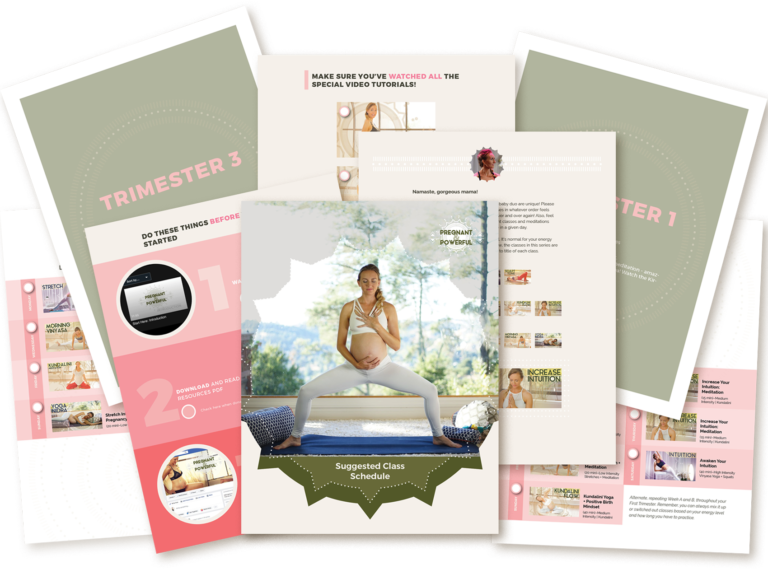
YOU MIGHT ALSO LIKE
- The Best Kundalini Yoga for Pregnancy: How to Practice Safely
- Yoga For Third Trimester: My Favorite Poses
- Home Birth vs Hospital Birth: Which is More Yogic?
- 9 Yoga Modifications for Pregnancy and How to Teach Them
- How To Relieve Pelvic Girdle Pain During Pregnancy
- What To Consider When Taking a YTT While Pregnant
- My Guided Pregnancy Meditation To De-Stress & Connect With Your Baby [VIDEO]
- 6 Natural Ways to Prepare Your Body For an Easy Labor & Delivery
- 6 Crazy Easy Pregnancy Meditation Tips For A Powerful Practice
- Six Essential Prenatal Yoga Poses for a Powerful Birth










